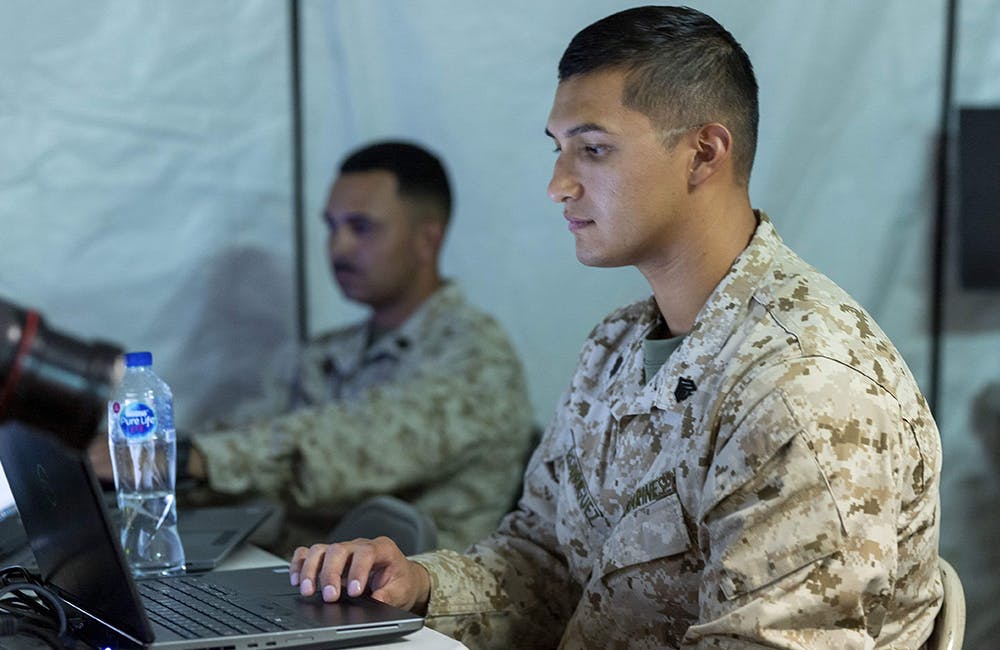How Defense Health is Aiding National COVID-19 Response
The Defense Health Agency and military officials are providing medical and technological personnel and resources across the country.

Defense health officials are rallying to the country’s COVID-19 pandemic response by contributing both medical and technical resources, personnel and capabilities.
DHA has established a Crisis Action Team to better meet the exponentially growing national demand for treatment and health resources, Defense Health Agency Director Gen. Ronald Place said in an agency address. The team is based at the DHA headquarters in northern Virginia and has personnel ready night and day, seven days a week, to address patient concerns and care, monitor blood supplies and share military health equipment and capabilities, Place said.
Place explained other areas of support that the military health system is expanding, including providing more patient bed space, examining appropriate trade-offs in shifting resources from one need to another, assisting Americans with self-screening and general testing of patients.
With the 500% increase in calls to DHA’s nurse advice line, ramping up capabilities within the military health system is critical.
“We are evaluating reducing elective procedures, to increase capacity, and I’ve directed doctors and nurses in staff positions to shift responsibilities to clinical patient care,” Place said. “We’re looking at how our clinics and hospitals might be able to surge bed space that isn’t currently being used for patient care. And the list goes on.”
Most recent military responses along the lines of Place’s words include Assistant Secretary of Defense for Health Affairs Thomas McCaffery’s Tuesday memorandum directing all military treatment facilities and dental treatment facilities to postpone all non-emergent surgeries for 60 days beginning March 31.
“It is essential that we take prompt action, informed by local conditions and your risk-benefit analysis,” McCaffery wrote to MTF and DTF commanders and directors. “I deeply appreciate your leadership role in our comprehensive response to the COVID-19 pandemic. The needs of the mission, the needs of the patient and local environmental conditions are all important considerations.”
The memorandum follows Monday’s deployment of hospital ship USNS Mercy from Naval Station San Diego to Los Angeles to support California’s COVID-19 response. The ship, which will serve as a referral hospital for non-COVID-19 patients currently admitted to coastal-based hospitals, won’t primarily treat COVID-19 patients. Rather, it will take on patients with other needs to free up nearby hospital resources and personnel.
“Mercy brings a team of medical professionals, medical equipment and supplies, all of which will act, in essence, as a ‘relief valve’ for local civilian hospitals in Los Angeles so that local health professionals can better focus on COVID-19 cases,” Mercy MTF Commanding Officer Capt. John Rotruck said.
The ship left for Los Angeles with over 800 Navy medical personnel and support staff, as well as 70 civil service mariners who will operate the ship, transfer mission cargo and provide essential services to keep the ship’s MTF running.
Defense Secretary Mark Esper added in a press conference this week that he anticipates deploying USNS Comfort, which is currently based in Norfolk, Virginia, to New York City to serve a similar purpose to USNS Mercy.
In coordination with the Federal Emergency Management Agency, five military field hospitals and expeditionary medical units are prepared to deploy and expected to mobilize this week across various parts of the country, particularly areas suffering from overloads of COVID-19 cases, Esper said.
“Right now, I anticipate sending a hospital to Seattle and a hospital [to] New York City,” Esper said. “Beyond that, once that’s confirmed, we will look at sending to other places and, as necessary, we will continue to alert units to prepare to deploy and then deploy them as appropriate.”
As the military continues to stretch its resources across the country, such as with the Army Corps of Engineers’ current work in converting nonmedical facilities into temporary medical facilities, Esper emphasized that he sees the military acting as “the gap-filler for a period of weeks with our capabilities” rather than a permanent solution to the pandemic.
Technological Response and Aid
Amid the broader “gap-filler” response that military medical officials and personnel are acting on, the DHA Solution Delivery Division is also supporting COVID-19 countermeasures ramping up national detection capabilities and using web and mobile technologies to monitor MTF bed occupancy statuses in real time.
SDD updated its Clinical Support Program Management Office’s Electronic Surveillance System for the Early Notification of Community-based Epidemics application, otherwise known as ESSENCE, and the AHLTA military electronic health record to increase the military health system’s ability to globally monitor for COVID-19 threats and outbreaks.
SDD reported In a March newsletter that it created a query tab in ESSENCE for the novel coronavirus, providing more updates and information to the COVID-19 query that the Centers for Disease Control and Prevention developed. More specifically, SDD’s query tab includes International Statistical Classification of Diseases and Related Health Problems codes, known as ICD-10, and critical information related to the pandemic.
The SDD EHR Core PMO also worked with the SDD Health Informatics team to update the AHLTA Tri-Service Workflow primary care forms to include COVID-19 travel screening information. These forms can help identify potentially infected individuals so that officials can further evaluate or isolate them in accordance with CDC guidance.
“The ESSENCE and AHLTA teams’ quick, innovative response to the COVID-19 outbreak demonstrated SDD’s ability to adapt and deliver solutions to the DHA, supporting their efforts to combat the disease nationwide,” SDD Chief Col. Francisco Dominicci said.
To help the military medical community better track the availability of resources and patient bed availability, SDD’s Web and Mobile Technology PMO recently developed a web-based dataset to monitor the bed occupancy status for 49 MTFs.
The WMT PMO created the dataset in CarePoint, which is DHA’s SharePoint site for medical-related data, and the dataset replaced Excel spreadsheets that MTFs previously used. The new dataset allows for more rapid and real-time updates of MTF’s bed occupancy status.
“The web-based solution allows multiple facilities to update their bed occupancy status at any time, eliminating the need to update and manually email the spreadsheet to multiple users,” SDD said in a newsletter. “WMT established item-level permissions for the data entries and designed the dataset to restrict updating authority to MTF-designated administrators.”
SDD added that anyone with CarePoint access can view the data, which is also exportable to Excel for customer reports. WMT is currently working to create custom views to give summary snapshots of the data as well.
This is a carousel with manually rotating slides. Use Next and Previous buttons to navigate or jump to a slide with the slide dots
-

Navy Expands Black Pearl Capabilities to Drive Operational Resilience
The Department of the Navy's Black Pearl software factory and Innovation Adoption Kit boost software development and operational resilience.
5m read -

How NASA’s AI Plan Boosts Government Efficiency
NASA Chief Data and AI Officer David Salvagnini shares how the agency is integrating AI with data to drive innovation and efficiency across government.
9m watch -

Modernizing IT Systems for AI Adoption
USPS, NIH and Lumen discuss how modernization, data strategies and security are shaping AI’s future role in government.
20m watch -

NSF Wants Industry Driving Quantum Innovation
The agency is pushing for partnerships to enhance the research community as Congress weighs additional legislation.
3m read








